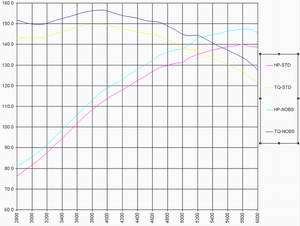The Alternator Disable test done shows a ~10% improvement in MPG’s. How much more resistance or harder can it be to spin an alternator compared to balancer unit?
Not a good comparison. The alternator is doing actual work, balance shafts are just spinning on a cushion of oil. If you have ever pedaled a stationary bicycle hooked up to an alternator and a simple switch with a light bulb, you know firsthand how much work it takes to light the bulb. As soon as the light is switched on the load goes way up.
If the Mazda 2.3 was dynoed at 3 hp gain from removing the balancer unit and it was tested an estimated 5.4 hp needed to spin the alternator at 40 mph on the metro then there probably will be some gain similar or more removing the bs.
No, and to understand why you need to understand that an inertia dyno does not actually measure HP, it tries to derive HP by measuring how fast it can spin up a heavy drum. It's necessary to include a number of fudge factors in the calculations to account for things like the rotating mass of the engine. Removing the balance shaft will allow the engine to spin up faster, mostly in the lower gears or in neutral, but it will not allow the rear wheels to output ANY more HP because HP is a steady state measurement.
Also have you guys ever tried a Wrist Exerciser Gyro before? This little thing has way less weight/mass than the balancer unit shafts and when spinning thousands of rpms it creates a lot of resistance on your wrist. Why wouldnt the bigger balance shaft not effect the motor enough to see gains worth doing?
I have three of those wrist gyro's and they are really cool. I use them to keep my forearms strong for motorcycle riding. But there is only resistance because, to keep it spinning, you constantly have to rotate the axis of the gyro in an elliptical orbit. The balance shafts in an engine never change direction relative to the engine. But this is an interesting point because the balance shafts will offer resistance to the vehicle turning or rotating in any direction except a rotation that has the same axis as the balance shafts. In a transversely mounted engine, this would be the pitch of the vehicle (where the balance shaft would NOT impede the motion of the vehicle). When making an abrupt tight turn, the balance shafts would offer resistance to the natural tendency of the car to have body roll. This is a good thing but it would not cause the vehicle to consume more fuel. Likewise, when making a tight turn, the balance shafts would resist the forces trying to turn the vehicle (yaw). This is a bad thing (reduces the nimble feeling of the steering) and causes the tires to work harder to maintain a given radius of turn at a given speed but it would not directly put significantly more load on the gears driving the balance shafts (because they are floating on a cushion of oil). There would be a slightly higher load placed on the engine due to the energy consumed by the tires forcing the car to yaw.
On the other hand, gyroscopic forces add stability to the vehicle. This can be a good thing (for example in assisting the vehicle to tract straight on glaze ice). But for racing purposes there would be a slight handling advantage to not have these gyroscopic forces present and also to allow the engine to spin up slightly faster under acceleration.
But no, removing them will not transform the car in any obvious manner except for the additional vibration (which is why they put them on there in the first place).


